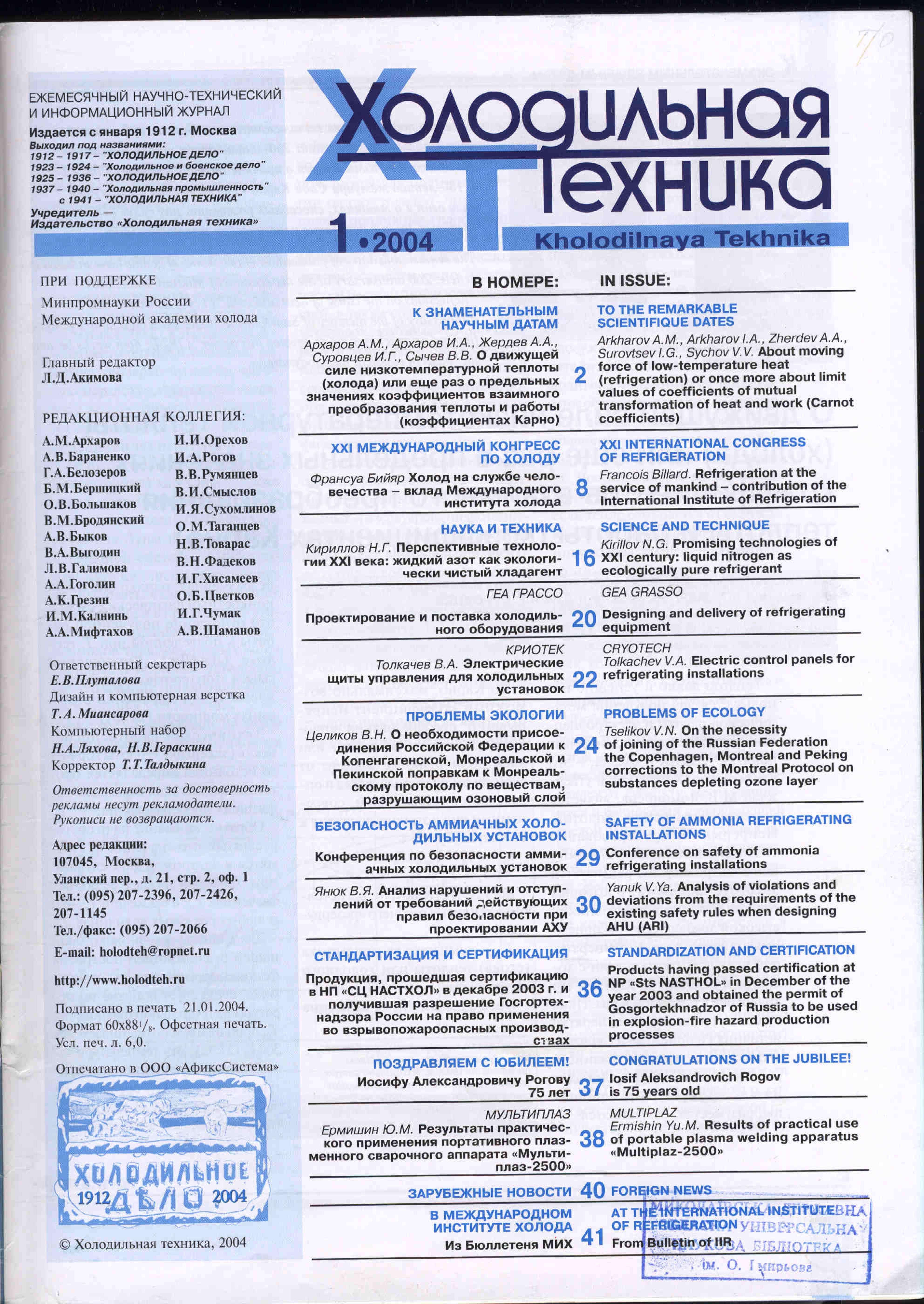Vol 93, No 1 (2004)
Articles
On the driving force of low-temperature heat (cold) or once again on the limiting values of the coefficients of mutual conversion of heat and work (Carnot coefficients)
Abstract
The remarkable dates of publication of two works of genius have induced this article: 260 anniversary of the dissertation of Mikhail Lomonosov “Reflections on the cause of heat and cold” (1744) as well as 180 anniversary of the memory of Sadi Carnot “Reflections on a motive power of fire and on machines apt to develop this power” (1824); both works became the basis of classical thermodynamics.
 2-7
2-7


Cold in the Service of Humanity - Contribution of the International Institute of Refrigeration
Abstract
Serving the needs of mankind is a continuous role of the HR since its outset. The presentation details in a first chapter the history of the HR and its major contributions in the context of health and well being of society. It then gives an overview of the most significant activities of the HR today and finally highlights major achievements for the refrigeration sector and the challenges for the future.
 8-14
8-14


Promising technologies of the 21st century: liquid nitrogen as an environmentally friendly refrigerant
Abstract
A possibility of use of low-temperature Stirling machines (KGM) for development of nitrogen cooling closed systems which are the alternative to straight-flow nitrogen systems is considered. The advantages of closed systems based on KGM Stirling are their independence, long operation time, low weight and dimensions. These systems can be used for thermostatting of the objects, for elimination of losses during storage of oil products and cryogenic liquids, in construction for production of high- quality concrete.
 16-19
16-19


 20-20
20-20


 21-22
21-22


On the need for the Russian Federation to join the Copenhagen, Montreal and Beijing amendments to the Montreal Protocol on Substances that Deplete the Ozone Layer
Abstract
Over the past two years, the consumption of controlled ozone-depleting substances widely used in refrigeration, listed in Group I of Annex C to the Montreal Protocol on Substances that Deplete the Ozone Layer, has increased in the domestic market of Russia - hydrochlorofluorocarbons (HCFCs) R21, R22, R141 b and R142b , which is due to the following main reasons: a significant reduction in the stocks of chlorofluorocarbons (CFCs) RI 1, R12, R13, R113, created by the time the production of these substances was completely closed on the territory of the Russian Federation in accordance with government decree No. 1000 of December 20, 2000.
 24-27
24-27


Ammonia Refrigeration Safety Conference
Abstract
On November 19-21, 2003, under the auspices of the Gesgortekhnadzor of Russia, the All-Russian Scientific and Technical Conference “Main trends in the development of refrigeration equipment at processing enterprises and trade enterprises” was held in Moscow. Issues related to the implementation of the requirements of the Safety Rules for ammonia refrigeration units. It was attended by representatives of enterprises and firms producing and operating ACS, research, design organizations and universities.
 29-29
29-29


Analysis of violations and deviations from the requirements of the current safety rules in the design of ACS
Abstract
The State Institute "Giprokholod" has a license of the Gosgortekhnadzor of Russia No. 00-DE-000437 for the right to conduct an industrial safety review of project documentation for the construction, expansion, reconstruction, technical re-equipment, conservation and liquidation of a hazardous production facility related to ammonia refrigeration units (ACU).
 30-32
30-32


 38-39
38-39


Office building using natural energy sources
Abstract
Germany has built the world's largest office building using natural energy sources (the so-called "passive building"). The 7000 m2 building will be able to employ 420 employees. On its facade, which has a rounded shape, there are no usual large windows. They open onto an internal atrium with a glass roof.
 40-40
40-40


 40-40
40-40









